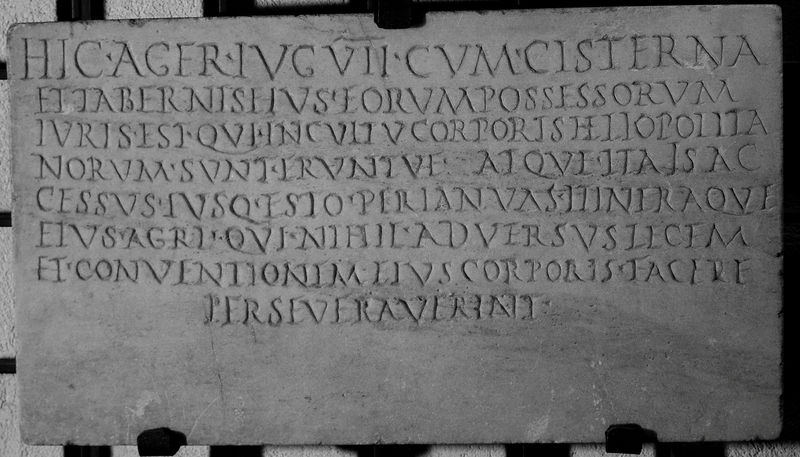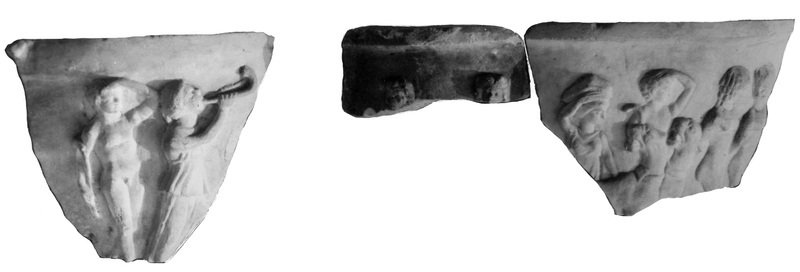A few inscriptions mention Berytus, modern Beirut in Lebanon, and Heliopolis or Baalbek, situated in the interior of Lebanon, to the north-east of Beirut and to the north of Damascus. The first was seen in Napels, but has long since disappeared. It is a statue base from 116 AD, set up for Trajan in 116 AD by people from Berytus who lived and worked in Puteoli (Berytenses qui Puteolis consistunt), and formed a group of worshippers (cultores) of Jupiter Heliopolitanus. In Baalbek remains of the temple of Jupiter Heliopolitanus can still be seen (some of the columns are in the Aya Sofia). It served as an oracle and was visited, among others, by Trajan.
IMP(eratori) CAESARI
DIVI NERVAE [f(ilio)]
[Nervae] TRAIAN(o)
OPTIMO AVG(usto) GERM(anico)
DACIC(o) PARTHIC(o) PONT(ifici)
MAX(imo) TRIB(unicia) POTEST(ate) XX
IMP(eratori) XII CO(n)S(uli) VI PATRI PATR(iae)
CVLTORES IOVIS HELIOPO
LITANI BERYTENSES QVI
PVTEOLIS CONSISTVNTEDR170317.
Berytus, baths. Photo: Wikimedia, Elgaard.People from Baalbek-Heliopolis itself are documented in an inscription that was found somewhere outside Pozzuoli.

HIC AGER IVG(erum) VII CVM CISTERNA
ET TABERNIS EIVS EORVM POSSESSORVM
IVRIS EST QVI IN CVLTV CORPORIS HELIOPOLITA
NORVM SVNT ERVNTVE ATQVE ITA IS AC
CESSVS IVSQ(ue) ESTO PER IANVAS ITINERAQUE
EIVS AGRI QVI NIHIL ADVERSVS LECEM
ET CONVENTIONEM EIVS CORPORIS FACERE
PERSEVERAVERINTThis terrain of 7 iugera, with a cistern
and its rooms, by right belongs to those
who are or will participate in the cult of the
guild of the Heliopolitans, and thus for those there
wiil be passage and right, through the doors and its
paths, who will not have persisted in doing
anything against the law and the agreement
of that guild.On a marble slab.
EDR111308. Photo: EDR.The size of the terrain was 17.600 square meters (133 x 133 m.). The collegium of the Heliopolitans had the status of corpus. The inscription is not earlier than the reign of Trajan, because he introduced the status of corpus ("body") for certain guilds. This status means that the guild performed tasks in the public interest, and received an exemption from certain duties (munera) in return. The name corpus Heliopolitanorum as such is meaningless and must be a shortened version of the full name. Because Heliopolis was not a harbour city, what is missing cannot be navicularii, "skippers". The full name may well have been corpus negotiatorum / negotiantium Heliopolitanorum, "guild of the merchants from Heliopolis". Use of the area was restricted to those members who participated in the cult of the guild, perhaps the cult of Jupiter Heliopolitanus. Apparently the guild had members that did not meet this condition. The only clues that we have for the purpose of this rather large area are a cistern and the tabernae, taberna being translated as "a booth, shop, workshop, stall, inn, tavern" by Lewis and Short. There is nothing to suggest funerary use, as has often been suggested.
Heliopolis, Temple of Bacchus, near the remains of the Temple of Jupiter Heliopolitanus.
Photo: Wikimedia, Saadedine Al Saidi.Jupiter Heliopolitanus features furthermore in a series of inscriptions from the 2nd and 3rd century. They document a temple of the god, somewhere in Puteoli. In relation to the god we also hear of a temple of the Geremellenses. The Geremellenses may have been citizens from a Semitic place or city, but are further unknown. A link has been suggested with the cognomen Garmalla in a funerary inscription from Puteoli (EDR158437). A curator was linked to the temple, which suggests a formal organization. Another fragment of an inscription contains the word Geremel[---] and mentions a person from Byblos, a harbour city in Lebanon.
[Ex] IVSSV I(ovis) O(ptimi) M(aximi) HELIOPOLITAN[i]
[aede]M DILAPSAM M(arcus) VLPIVS SABINVS AEDITVS I[---]EX IVSSV I(ovis)
O(ptimi) M(aximi) H(eliopolitani)
C(aio) STENNIO CRISPO
SACERDOTI ET CVRA
TORI SACERDOTES ET
ZYGOFORIEX IVSSO I(ovis) O(ptimi) M(aximi) HELIO
POLITANI AVR(elio) THEODO
RO SACERDOTI FILIO CVRATOR(i)
TEMPVLI GEREMELLENSIVM
ADAMPLIANTE DONIS TOR
QVEM <<ET VELVM>> SAC(erdotes)
ET IVCOPHORI DE SVO POSVERVNT
CVRANTE ACILIO SECVNDO TROTO
MIAS (?) [---]On a marble architrave.
EDR071689.On a marble base.
EDR100487.On a marble base.
EDR102398.

I(ovi) O(ptimo) M(aximo) H(eliopolitano) [---]VS HERMIANVS SACERDOS D(onum) [d(edit)] On the rim of a large marble vessel (l. 0.77). On the side of the vessel is a relief of a Bacchic thiasus.
EDR107182. Photos: EDR. Now in Trieste.The south-west part of Syria, with Tyrus, was called Syria Phoenice, the south-east part, with Berytus and Heliopolis, Coele-Syria. The main city in the northern part of Syria was Antiochia on the Orontes (Antakya, Turkey). Some of the evidence from Puteoli refers to Syria without further specification. An inscription on a marble column found near Pozzuoli documents a dedication to domina Dasyria. Dasyria, normally Dea Syria, is another name for the Syrian deity Baalat. Her main sanctuary was in Hierapolis in modern Syria. One of the objects dedicated was a leontochasma, a gargoyle or the waterspout of a fountain in the shape of the head of a lion. In Pozzuoli the funerary inscription was found of Faenia Felicitas, natione Syra, who died at the age of 40. It was put up by her husband Saturnus Antiochus.
Top. The funerary inscription of Faenia Felicitas.
EDR135622. Photo: EDR.
D(is) M(anibus)
FAENIA FELICITAS
NAT(ione) SYRA VIXIT ANN(is) XL
SATVRNVS ANTIOCHVS
COIVGI
B(ene) M(erenti) F(ecit)
Left. The dedication to domina Dasyria.
EDR166179. Photo: Zevi et al 2008, p. 71.
ET LEONTO
XASMA DE
AE D(ominae) DASYR(iae)
POSVER(unt)